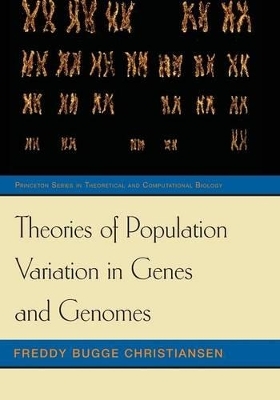
Theories of Population Variation in Genes and Genomes
Princeton University Press (Verlag)
978-0-691-16589-9 (ISBN)
* Contains up-to-date treatment of key areas in classical and modern theoretical population genetics * Provides in-depth coverage of coalescent theory * Discusses genomic effects of selection * Gives examples from empirical population genetics * Incorporates figures, diagrams, and boxed features throughout * Includes end-of-chapter exercises * Speaks to a wide range of students in biology, bioinformatics, and biostatistics
Freddy Bugge Christiansen is professor of population biology at the University of Aarhus in Denmark. He is the author of Population Genetics of Multiple Loci and coauthor of Theories of Populations in Biological Communities and Population Genetics.
Preface and Acknowledgments ix Introduction 1 Part I: Genetic Variation 5 Chapter 1: Genetics 7 1.1 Genetic Variation 9 1.1.1 Gene structure and function 13 1.1.2 Molecular genetic variation 17 Chapter 2: Conservation of Variation 21 2.1 Stochastic Fluctuations 23 2.2 Wright-Fisher Process 26 2.2.1 Multiple alleles 30 2.3 Gene Identity in a Finite Population 31 2.4 Coalescence of Genes 33 2.5 Characteristic Time Unit 41 2.6 Diffusion Approximation 42 2.6.1 The Wright-Fisher model 43 2.6.2 The coalescent 46 2.6.3 The 1-coalescent 49 2.7 Moran's Model 50 Chapter 3: Diploid Populations 53 3.1 Random Mating 54 3.1.1 Mating of individuals 58 3.1.2 Random mating and selfing 59 3.2 Effective Population Size 62 3.2.1 Lose variation or gain identity 64 3.2.2 An exponentially growing population 64 3.2.3 Overlapping generations 68 3.3 Genotypic Frequencies 69 Chapter 4: Mutation and Variation 71 4.1 Mutation 72 4.1.1 Induced mutation 74 4.1.2 Somatic mutation 75 4.1.3 Effects of mutations 76 4.2 The Two-Allele Model 77 4.2.1 Distribution of the gene frequency 80 4.3 Genealogy and Variation 84 4.3.1 Alcohol dehydrogenase in Drosophila 86 4.4 Mutation and Coalescence 87 4.4.1 The appearance of a sample 91 4.4.2 Gene identity and mutation 93 4.5 The Infinite Alleles Model 95 4.5.1 Heterozygosity in the infinite alleles model 99 4.6 The Infinite Sites Model 100 4.7 Age of an Allele 104 4.8 Numerical Simulations 105 Chapter 5: Migration 108 5.1 Population Genetics of Migration 109 5.1.1 Genealogy in a structured population 112 5.1.2 The final waiting time 115 5.2 Population Structure 118 5.2.1 The simple two-island model 121 5.2.2 Coalescence in a widespread population 124 5.2.3 Strong migration 128 5.2.4 The stepping-stone model 129 5.3 Genotypic Proportions 133 5.3.1 Description of population structure 135 Chapter 6: Linkage 139 6.1 The Karyotype 141 6.1.1 Sex linkage 143 6.1.2 Linkage map 144 6.2 Population Genetics of Linkage 148 6.3 Linkage Equilibrium 150 6.3.1 The forward equations 155 6.3.2 Population mixing 156 6.3.3 Recurrent mixing and migration 157 6.3.4 Stochastic effects 159 6.3.5 Backcrosses 160 6.4 The Ancestral Recombination Graph 161 6.4.1 Genealogy and recombination 167 6.4.2 The mechanism of recombination 171 6.4.3 Gene conversion 173 6.4.4 The APOE risk factor in Alzheimer's disease 174 6.5 Recombination and Physical Distance 177 Chapter 7: Phenotypic Variation 181 7.1 Quantitative Inheritance 185 7.1.1 Conservation of variation 186 7.1.2 Random genetic drift 187 7.2 Kin Resemblance 188 7.2.1 The additive model 190 7.2.2 Parent-offspring covariance 191 7.2.3 Covariance between sibs 194 7.3 Inference on the Genotypic Variance 195 7.3.1 Comparison of populations 199 7.3.2 Random genetic drift 201 7.3.3 Applications of quantitative genetics 202 7.4 Mapping of Quantitative Trait Loci 202 7.4.1 Diallel crosses 204 7.4.2 Inference 207 Part II: Variation and Selection 213 Chapter 8: Effects of Selection 216 8.1 Selection Components 219 8.2 Viability Selection 222 8.2.1 Viability selection in Zoarces 233 8.3 Selection on a Quantitative Character 234 8.3.1 Genetic effects of selection 236 8.3.2 Fitness maximization 241 8.3.3 An experiment on growth rate in Mus 243 8.4 Mutation and Selection 245 8.4.1 Mutation, selection, and variation 248 8.5 Stability of an Equilibrium 248 8.6 The Coalescent and Selection 255 8.6.1 Microcephalin alleles in humans 259 8.6.2 Adh alleles in Drosophila 260 Chapter 9: Genomic Effects of Selection 264 9.1 Multilocus Selection 268 9.1.1 Selection on one of the loci 271 9.1.2 Tight linkage 272 9.1.3 Loose linkage and weak selection 275 9.1.4 Intermediate linkage 277 9.2 Selection Experiments in Drosophila 279 9.2.1 An experiment using the ebony allele 281 9.2.2 An experiment using white alleles 283 9.3 Hitchhiking 285 9.3.1 An experiment on a bristle character in Drosophila 289 9.4 Inbreeding Depression 291 9.4.1 Inbreeding in inbred populations 295 9.4.2 Hitchhiking and inbreeding depression 296 9.4.3 Inbreeding effects on a bristle character 298 9.5 Sweeps by Selection 301 9.5.1 Selection on a bristle character 306 Chapter 10: Population Structure 309 10.1 Polymorphism 310 10.1.1 Local and global effects of selection 312 10.1.2 Transient polymorphism 313 10.1.3 Migration-selection balance 314 10.1.4 Environmental homogeneity 316 10.1.5 A butterfly metapopulation 318 10.1.6 Geographical variation in another butterfly 319 10.2 Introgression 320 10.2.1 Karyotypic variation 322 10.2.2 Genetic barrier 330 10.2.3 Introgression of a microcephalin allele 334 10.2.4 Vertical transmission of infection 335 10.2.5 Emerging barrier 336 10.3 Divergence of Populations 338 Appendix: Probability Theory and Statistics 345 A.1 Discrete Stochastic Variables 345 A.1.1 Moments 347 A.1.2 Conditional probabilities 348 A.1.3 The binomial distribution 351 A.1.4 The geometric distribution 352 A.1.5 The Poisson distribution 355 A.2 Markov Chains 355 A.3 Continuous Random Variables 359 A.3.1 The exponential distribution 360 A.3.2 The Gaussian distribution 361 B Solutions to Exercises 363 Bibliography 383 Index 413
| Reihe/Serie | Princeton Series in Theoretical and Computational Biology |
|---|---|
| Zusatzinfo | 100 color illus. 100 line illus. 46 tables. |
| Verlagsort | New Jersey |
| Sprache | englisch |
| Maße | 178 x 254 mm |
| Gewicht | 482 g |
| Themenwelt | Naturwissenschaften ► Biologie ► Genetik / Molekularbiologie |
| ISBN-10 | 0-691-16589-0 / 0691165890 |
| ISBN-13 | 978-0-691-16589-9 / 9780691165899 |
| Zustand | Neuware |
| Haben Sie eine Frage zum Produkt? |
aus dem Bereich


